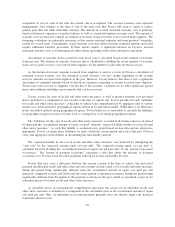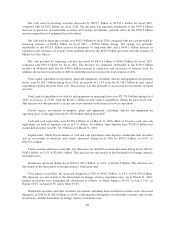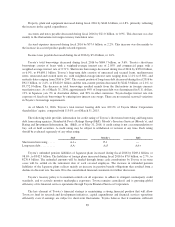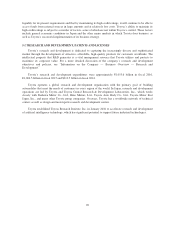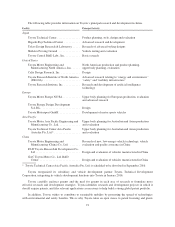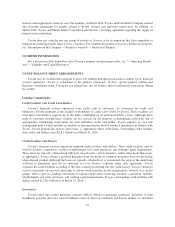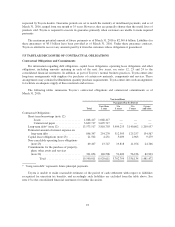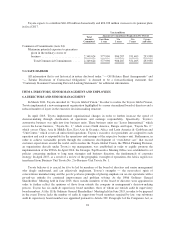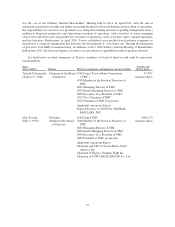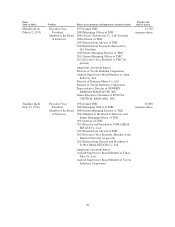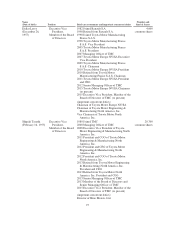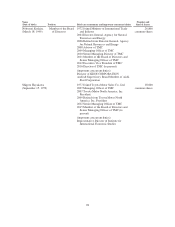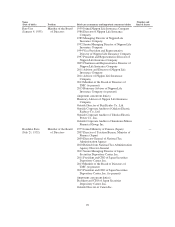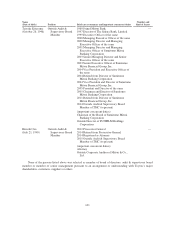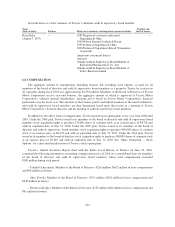Toyota 2015 Annual Report Download - page 97
Download and view the complete annual report
Please find page 97 of the 2015 Toyota annual report below. You can navigate through the pages in the report by either clicking on the pages listed below, or by using the keyword search tool below to find specific information within the annual report.licenses when appropriate terms are met. For example, in March 2004, Toyota and Ford Motor Company entered
into licensing agreements for patents related to hybrid systems and emissions purification. In addition, in
March 2010, Toyota and Mazda Motor Corporation entered into a licensing agreement regarding the supply of
hybrid system technology.
Toyota does not consider any one group of patents or licenses to be so important that their expiration or
termination would materially affect Toyota’s business. For a further discussion of Toyota’s intellectual property,
see “Information on the Company — Business Overview — Intellectual Property.”
5.D TREND INFORMATION
For a discussion of the trends that affect Toyota’s business and operating results, see “— Operating Results”
and “— Liquidity and Capital Resources.”
5.E OFF-BALANCE SHEET ARRANGEMENTS
Toyota uses its securitization program as part of its funding through special purpose entities for its financial
services operations. Toyota is considered as the primary beneficiary of these special purpose entities and
therefore consolidates them. Toyota has not entered into any off-balance sheet securitization transactions during
fiscal 2016.
Lending Commitments
Credit Facilities with Credit Card Holders
Toyota’s financial services operations issue credit cards to customers. As customary for credit card
businesses, Toyota maintains credit facilities with holders of credit cards issued by Toyota. These facilities are
used upon each holder’s requests up to the limits established on an individual holder’s basis. Although loans
made to customers through these facilities are not secured, for the purposes of minimizing credit risks and of
appropriately establishing credit limits for each individual credit card holder, Toyota employs its own risk
management policy which includes an analysis of information provided by financial institutions in alliance with
Toyota. Toyota periodically reviews and revises, as appropriate, these credit limits. Outstanding credit facilities
with credit card holders were ¥218.5 billion as of March 31, 2016.
Credit Facilities with Dealers
Toyota’s financial services operations maintain credit facilities with dealers. These credit facilities may be
used for business acquisitions, facilities refurbishment, real estate purchases, and working capital requirements.
These loans are typically collateralized with liens on real estate, vehicle inventory, and/or other dealership assets,
as appropriate. Toyota obtains a personal guarantee from the dealer or corporate guarantee from the dealership
when deemed prudent. Although the loans are typically collateralized or guaranteed, the value of the underlying
collateral or guarantees may not be sufficient to cover Toyota’s exposure under such agreements. Toyota
evaluates the credit facilities according to the risks assumed in entering into the credit facility. Toyota’s financial
services operations also provide financing to various multi-franchise dealer organizations, referred to as dealer
groups, often as part of a lending consortium, for wholesale inventory financing, business acquisitions, facilities
refurbishment, real estate purchases, and working capital requirements. Toyota’s outstanding credit facilities with
dealers totaled ¥2,259.3 billion as of March 31, 2016.
Guarantees
Toyota enters into certain guarantee contracts with its dealers to guarantee customers’ payments of their
installment payables that arise from installment contracts between customers and Toyota dealers, as and when
92


